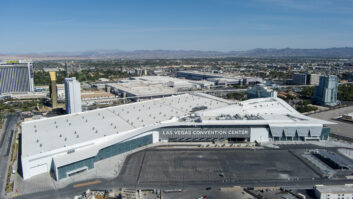While listeners may associate radio with disembodied voices or the sounds of sports or musical instruments, Radio World readers are well aware of the importance of the physical equipment used to produce and transmit content — and also the buildings that house that equipment.
Trans World Radio, a nonprofit Christian ministry that evangelizes internationally through radio programming, sees the replacement of a leaky roof in its Cary, N.C., office as crucial. The organization is trying to raise funds to replace the roof on its Americas regional and international headquarters. Here TWR produces and distributes radio programming primarily to affiliated stations in the Western Hemisphere; about 70 people work there.
It put out a newsletter titled “When It Rains, It Pours.” It told readers that the staff had to grab trash cans and buckets to catch drips of water, and asked for donations. “This is a serious situation as it puts the building, along with its equipment and furnishings, at risk — not to mention that it keeps us from focusing on our mission here at Trans World Radio.” And it posted a video making its pitch (see below).
The organization was founded in 1952 by Dr. Paul E. Freed with the goal of broadcasting in then-communist Spain. It uses multiple platforms to reach its audiences. Because of the variety of needs and technological resources available in the many countries it serves, TWR employs high-powered AM/MW, shortwave and FM radio, in addition to streaming content to Internet users.
According to Alexander Knauss, former maintenance coordinator for TWR’s Cary office, the roof project is expected to cost $89,814. Knauss was trained in historic preservation by the National Parks Service, and he emphasized the roof’s importance:“The number one thing they will always say, when it comes to building maintenance and historic restoration, is [to maintain] the integrity of the roof of the structure.”
Although the office was built in 1991, Knauss emphasizes that maintenance and preventative care are crucial, no matter the age of a structure. “Because we have been good stewards, we have been able to extend the life expectancy of this particular type of roof by about a decade,” he said. “We’ve certainly had to do some repairs along the way, but I believe we’ve taken good care of it.”
Over the years, the roof has produced anxiety. Knauss explained that heavy rain storms, which are not uncommon in Cary, produce very specific concerns. “You’ll actually get a pond up there maybe, which rises above the rocks and can sit an inch above the rocks. Of course, that’s a tremendous amount of water weight on that roof,” he said. “If there are any leaks, potential seams that could create a leak, that’s when you’re going to have them, too.”
“Obviously, from a radio broadcaster’s perspective, they do not want to have ceiling tiles come down on their equipment. They do not want to have water migrating down on very expensive sound or recording equipment.” A new roof should also cut cooling costs. The white thermo plastic polyolefin material will reflect the sun’s rays and better insulate the building, allowing the facility to operate with smaller HVAC units.
Additionally, if a leak should appear, it will be much easier to locate the source. At present the staff must track every leak on an overlay of the building’s blueprints before heading up to the roof, clearing off the rock ballast system and, finally, repairing the fissure.
(The roof not only shelters but supports equipment. “There is some minimal new dish system we put up there on the roof to capture news feeds,” Knauss said. “Our president, Lauren Libby, is a ham radioman, and he can’t get that out of his blood. So he has got an antennae system up on the roof, too. He loves to hear our transmissions from some of our world sites. He has that coming down into the building and can show our cooperating broadcasters what the sound of an actual show is like from point A to point B. Even though we’re not a target area here, you can still pick up many of our stations with good reception.”)
Even in the age of online streaming and social media (which have been incorporated into the organization’s outreach), traditional radio is still the key medium for TWR’s ministry. “There are many areas of the world where radio is still the number one way of getting into remote areas or areas where they certainly put restrictions on the use of Internet,” Knauss said.
Libby is featured in the fundraising video below.












